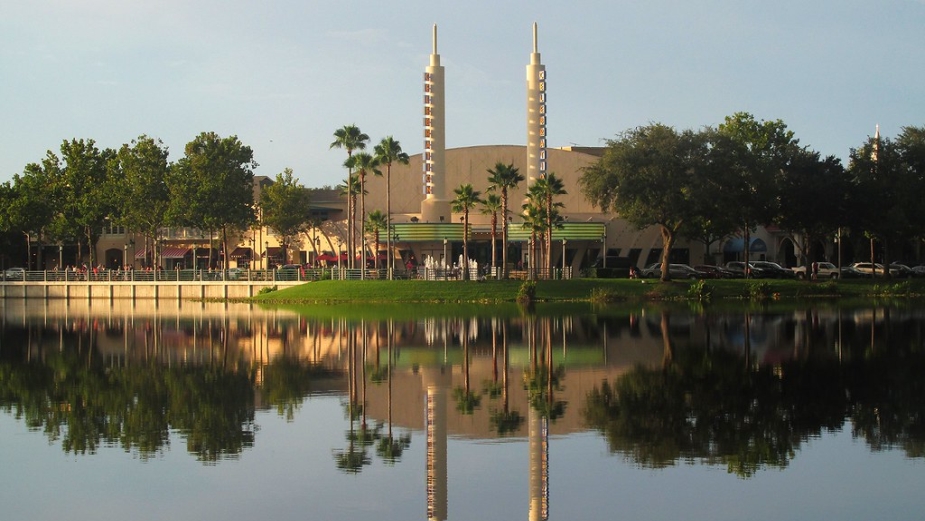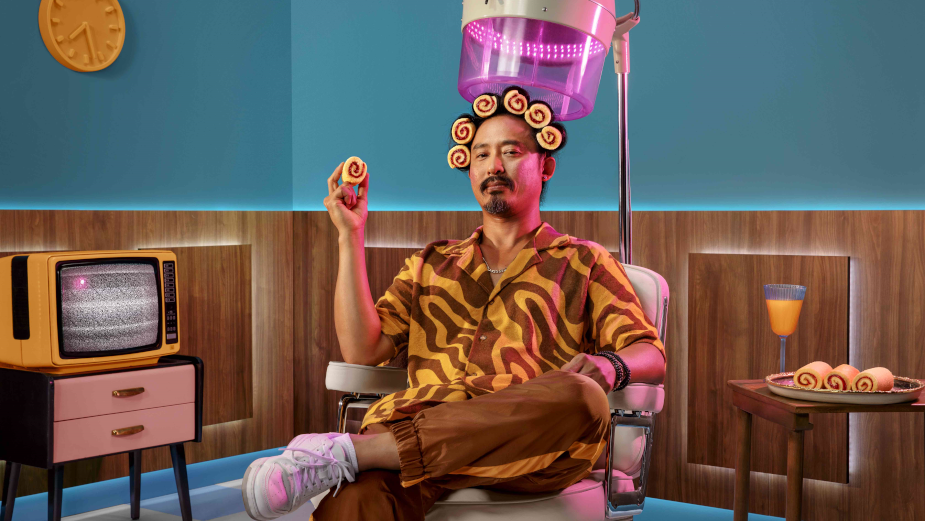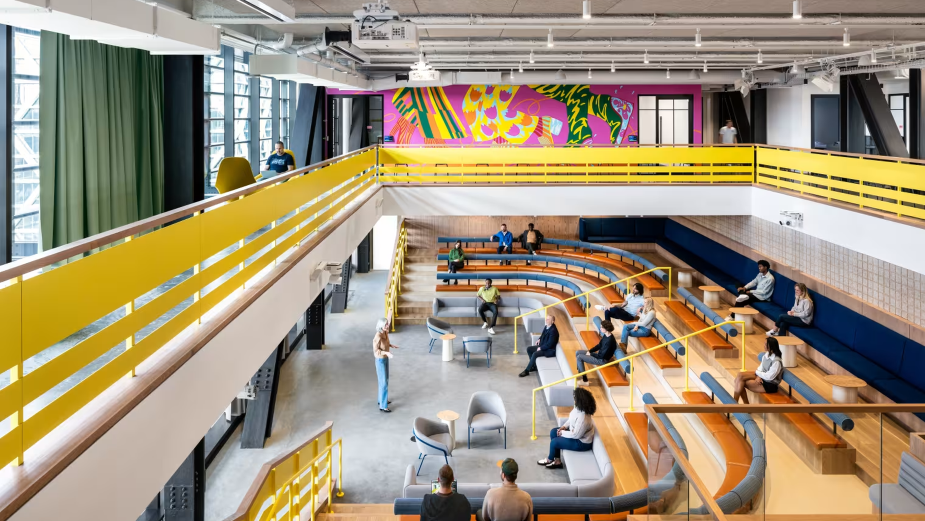
5 Minutes with… Katie Potochney

Katie Potochney has been practicing graphic design since before she knew her times tables, telling her mother she wanted to be a ‘computer artist’ as a child in 1991.
After moving to a ‘Truman Show’-esque community in Florida built by Disney - more on that later - Katie designed for her high school sports teams and attended summer classes to develop her skills, which led to her studying communication design, with a focus in advertising art direction, at Brooklyn’s Pratt Institute. This laid the foundation for her future career, now combining her graphic design and commercial skills as executive creative director for the email and marketing automations platform Intuit Mailchimp, and heading up its in-house agency, Wink Creative.
Speaking to LBB’s Ben Conway, Katie discusses her career journey through renowned agencies, like Johannes Leonardo, Lowe and Droga5, jumping brand-side with Etsy, how she’s currently marrying design and advertising at Wink, and the recent projects that she’s most proud of.
LBB> What creative content inspired or interested you most when you were growing up? Do any TV shows, films and ads stand out to you?
Katie> I was a pretty typical kid growing up in the ‘90s, obsessed with ‘Daria’, Alanis Morissette, ‘Ren & Stimpy’, ‘Romeo+Juliet’, ‘Memento’, etc. But I was also a pretty nerdy only child, hiding up in my room on my Mac drawing in KidPix, cruising through Encarta, playing ' The Oregon Trail', and tinkering with early versions of Photoshop, while watching 'Star Trek: The Next Generation' every night with my family.
As a teenager, we moved from upstate New York down to Celebration, Florida, a community built by Disney. It was based on Walt Disney's initial vision for EPCOT - the “experimental prototype community of tomorrow”. It was a huge ‘new urbanism’ experiment with civic buildings by famous architects, and a unique layout created to foster more interaction between neighbours. The wayfinding system and town seal were even designed by Pentagram. To many visitors, it gave ‘The Truman Show’ vibes, but for me, Celebration was a wild, immersive experience that was super fun to run around as a teenager. Looking back, I think Celebration’s Disney magic sparked my passion for design, storytelling, and a fascination for how to authentically build community.

Above: Celebration, Florida (photo: Chad Sparkes)
LBB> Was design always a passion of yours? How did that skill and interest develop for you?
Katie> Growing up, I vividly remember telling my mom I wanted to become ‘a computer artist’ - this was in 1991. Fortunately, my parents got me Photoshop 1.0 that year, so I have been practicing graphic design since before I learned multiplication. I designed all of my high school band and sports teams’ t-shirts, annual planner covers, school signage, murals, anything I could get my hands on. I even loved doing PowerPoint presentations because that was my way of practicing typography and layout.
I did high school summer sessions for graphic design at SCAD and at the Yale School of Art, taught by MFA design grad students who introduced me to logo design, Illustrator, and designing these new things on the internet called ‘blogs’. I graduated valedictorian of my class and dutifully applied to regular liberal arts colleges with my head, but applied to art and design schools with my heart. In the end, the heart won and I graduated from Pratt [Institute] with a degree in communication design, focused in advertising art direction.
LBB> Later on, you went back to Pratt and taught graphic design and advertising - how did that experience working with the next generation of designers and ad people change your outlook?
Katie> Teaching at Pratt was, of course, a wonderful full-circle experience, and being able to impact the next generation was not something I took lightly. I prioritised design craft in my ad classes, as well the ‘what they won’t teach you in school’ type of intel that I wish I’d had when I was a student - like business basics, client relationships, the realities of pitching, agency org structure, how to sell your work, etc.
Anyone who’s taught knows the challenge of having to articulate to a new audience the things that come naturally to you. That weekly reflection on my own practice definitely had a positive impact on me to become a more thoughtful creative leader.
LBB> How did you first break into the ad world? What attracted you to this industry?
Katie> Early on in college I found my first Lürzers Archive at St. Mark’s Bookshop and that’s what got me. The work was hilarious and smart and it swayed me - I wanted to learn how to do that. I studied ads on TV, and read all the essentials, highlighting and scribbling all over the pages of ‘Ogilvy on Advertising’ and ‘Hey Whipple, Squeeze This’ like I was studying for the Bar.
I was accepted into the fantastic internship program at Lowe during my senior year, and landed a full-time job there out of college, working on XM Satellite Radio. An XM spot I concepted, designed and art directed was on TV within months - I was beside myself with excitement.
The people in this industry are so relentlessly talented and passionate with a desire to create culture through storytelling that pushes on all our human levers, with a very clear intention and goal in mind. That fusion of strategy, persuasion and creativity is what’s kept me hooked.

Above: Still from Mailchimp's ‘Guess Less, Sell More’ campaign
LBB> Your career has taken you through some of the most renowned agencies, like Johannes Leonardo and Droga5. What were the most important projects and lessons you experienced during agency life? How does that influence you and your work today?
Katie> I was the second employee hired at Johannes Leonardo and had a front row seat for the birth of a new ad agency, quite literally, as I sat across from Jan and Leo every day for three years. It was as much a creative masterclass as it was a backstage pass, observing how they worked concepts as a team, the way they evaluated ideas, their strategic approach with clients, and how high the bar should be (and it was very, very high). As a young art director, I learned to be prolific, not too precious with my work and how to recognise great ideas - and perhaps more importantly, the bad ones. JL taught me resilience and gave me a really unique perspective, having worn many, many hats helping run a start-up agency. I feel really proud to have been part of JL’s origin story and am so thrilled for their success today.
At Droga I gained deeper production experience, and got more exposure to a larger agency’s fast-paced, competitive culture as they ascended to new heights in the late aughts. It was an electric place and I loved being part of that creative community which ran 24/7 - “Dinner’s here!” - IYKYK.
Gradually, I realised ad agency culture wasn’t for me. So I made a huge career pivot to join SYPartners, a transformation design firm. It was pitched to me as ‘Cirque du Soleil for business’ and I said, ‘yep, sign me up’. At SYP, designers and strategists worked in duos to ‘engineer epiphanies’ for clients in the form of powerful in-person experiences that helped transform their businesses, provoking CEOs and their teams to envision new futures, bold brand strategies and evolved company culture.
My agency experience has given me many gifts. I feel deep empathy for the agencies I work with today, knowing what goes on behind the scenes and how hard it can be when a client doesn’t set you up for success. I’m able to look at my team’s work with a legitimate point of view because I am a designer and art director by trade. And now, running my in-house teams, I make sure to take what worked in the agency world and leave what didn’t.
LBB> You first jumped brand-side with Etsy - what inspired that decision? What were the most rewarding and significant parts of your time there?
Katie> JetBlue had always been a brand I’d admired since college and they were a client of ours at SYPartners. The team put together a whole designed experience for the thousands of JetBlue employees to enter a new stage of brand transformation. At the end of the project, there was an in-house creative team at JetBlue who got to take the baton from us and operationalise the work. I felt so jealous! It was a feeling I had had many times, after handing off a huge campaign or finishing a client engagement, just praying that the work would stick inside the business, with no way of helping see it through.
That’s when I knew I wanted to go in-house. I wanted to usher great ideas into the business myself. I wanted to understand the real reasons behind why the CMO rejected an idea, why the marketing budget got cut, why a strategy did or didn’t succeed. I wanted to become a great client.
Pretty soon after that, Julia Hoffmann, Etsy’s ECD at the time, reached out to me about a CD role. It was a dream opportunity to work with Julia (a design idol of mine) on a brand I was incredibly loyal to as a crafter/maker and passionate supporter of small businesses. At Etsy, I got the unvarnished in-house exposure I was hoping for, learning about product roadmaps and corporate shake-ups and all the inner workings of a marketing team. It clarified so many things for me and I was able to tap my skills from advertising, design and consulting to influence and advocate for great visual design in the product, introduce the practice of brand planning in-house, and set up Etsy’s first paid media creative program.
LBB> You then moved to Intuit Mailchimp, where you’ve been for over four years as a design director, ECD and head of Wink Creative - the company’s in-house agency. How different has this role been to your previous ones?
Katie> Each in-house situation is different because it depends on everything from the industry to the org structure to the experience of the leadership team and their point of view on agencies. In some cases, you have close proximity to the product with no access to the marketing organisation. Sometimes it’s the opposite.
At that time, Etsy didn't really need to prioritise distinctive branding because its business model was already inherently differentiated. And that was always the struggle - trying to define and boost the brand without eclipsing the sellers’ micro-brands in the unique Etsy marketplace. I worked to strike that balance in surgical and strategic ways; a brand identity refresh via Etsy’s UX design system, the company’s first-ever brand positioning, and introducing above-the-line advertising strategies to the new C-suite.
At Intuit Mailchimp, it’s somewhat the opposite. My role has been all about brand and staying ‘Mailchimpy’, since that’s our main differentiator as a marketing automation platform. So a full-stack, in-house team makes a ton of sense for us, and that has made it smoother for me to build and develop Wink - even through a huge acquisition by Intuit.
Building and leading Wink has been the highlight of my career, and it’s exactly what I wanted to achieve when I started in 2019. And thanks to this brilliant motley crew, we have done it in a fraction of the time I had expected. Beyond the recognition and investment from the business, winning something like AdAge’s ‘A-List In-House Agency of the Year’ for 2023 was tremendous validation that we’re going in the right direction. The team is really hitting its stride, and with my blend of player/coach responsibilities to keep setting them up for success, it’s honestly everything I’ve hoped for so far in my career.
LBB> How are you leading and shaping what Wink is doing right now? What are some of your key goals and ambitions for the agency and Intuit Mailchimp more widely?
Katie> A big part of Wink’s secret sauce is the marriage of design and advertising. It’s a dichotomy that I felt was lacking back when I worked in agencies. From the outset, I’ve structured Wink to have both crafts as equals, working across all projects, with two incredible GCDs, Jeremy Jones and Christian Widlic, leading campaigns and design, respectively. This duality empowers us to find the ‘brief behind the brief’, whether it’s a hidden design identity we need to support a campaign brief, or an integrated campaign that we need to promote a design-led exhibition brief. It helps us keep the bar high for craft and persuasion, and still execute at speed and quality without missing a beat.
My ambition for Wink is to scale our remit and bring to bear the richness of Mailchimp’s personality across the entire Intuit ecosystem, consistently showing up with the best of the best across the creative industry. As we’ve delivered tangible business results and have built up our reputation, I’ve entered new business mode, championing Wink and proactively stirring up new partnerships where we can bring even more impact. The customer doesn’t care about our structure, and it’s one of my biggest pet peeves when business silos fracture the work. So I connect dots and build bridges between Wink and other teams at Intuit Mailchimp - product, customer education, sales, tech partnerships, etc. - to bring the brand to life coherently and delightfully wherever people find us.
LBB> Are there any recent projects that you’re particularly proud of? Tell us a bit about them!
Katie> There are so many projects I’m proud of - the ones that are more behind the scenes as much as the ones that make headlines. One project is ‘Email is Dead’, an ode to email brought to life as an exhibition at the Design Museum in London. We took visitors on a journey through the history of email, from its embryonic beginnings in the 1970s to what the email experience might look like in 2070. It was a gorgeously designed meditation on how email’s impact goes far beyond communications, and has been woven into the fabric of culture. Email is a technology almost every human can relate to, and it’s our conversation to own, which the Wink team have done brilliantly.
Another project I’m super proud of is ‘Turn Clustomers Into Customers’, our newest global brand campaign. We invented the word ‘Clustomer’ to describe the blob of undifferentiated customers businesses face when they don’t personalise their marketing. Mailchimp offers segmentation and automation tools that help marketers break up their Clustomer and speak to their customers more personally to grow their business. The Clustomer is such an iconic, strange and smart device - so smart that my dad saw it on TV with zero context and understood this esoteric B2B concept right away, without any explanation! It’s very exciting to be out there showing the huge potential of B2B creative.
Above: 'Turn Clustomers Into Customers'
LBB> You lead over 30 creatives across multiple disciplines - design, ad campaigns, studio production, app experiences and more - how do you keep everything centralised and cohesive? What does your day-to-day look like?
Katie> We’ve designed super-robust creative systems to help us scale our brand across touchpoints, which are flexible enough to not limit expression. But guidelines can only go so far. We also work hard to communicate and cross-pollinate. Wink has become a system of creative people who share knowledge, lend a hand and work on projects outside their typical lanes. It leads to a more organic kind of ‘Mailchimpy’ cohesion, rooted in our team’s shared instincts and our brand archetype, the ‘expert absurdist’. That’s our compass to ensure our work always has a wink and a dash of oddness or irreverence.
I nerd out on operationalising creativity in these concrete and human-centric ways, which is good because it is a big part of my job. I spend a lot of time as an upstream strategic partner to my marketing peers, who are lovely people I care about, and who have signed up for this in-house thing right alongside Wink. Our relationships must be healthy, authentic and trustworthy for us to be successful so we can continue to be Mailchimp’s agency of record.
Strategically, the briefs we receive and co-author need to ladder up to an overall brand experience for our audiences, so I work hard to lead and influence the entire creative roadmap to be more integrated. That way, by the time it lands on Wink’s doorstep, it’s ideally already part of a holistic plan and Wink doesn’t have to waste time reconciling the work into a cohesive whole - they can focus on coming up with breakthrough ideas.
LBB> We recently spoke to Christian Widlic about your new HQ in Atlanta - how are you enjoying that space?
Katie> This was one of those huge opportunities hidden in plain sight that ended up capturing the imaginations of people across the business beyond just our brand and marketing acts. It’s been really magical to see colleagues from across Intuit explore the HQ and really feel the spirit of who we are in this new chapter of Intuit Mailchimp.
You don’t often see an internal agency so involved in the design of a company’s physical space, but our team worked overtime to make sure it wasn’t a cookie-cutter office design and instead became a custom, authentic expression of our brand. We designed it to feel like a small city, with neighbourhoods filled with meeting rooms designed to look like storefronts, and tons of delicious details, textural variety, and easter eggs hidden throughout. My favourite aspect of the HQ has to be our 200+ custom works of art from around the world, with a different art movement living on each floor. Our employees now have access to a world-class art collection that activates our shared spaces with life, craft and stories. It’s a really magnetic place where people are excited to return to work.

Above: Mailchimp's Atlanta HQ
LBB> What’s exciting you most about marketing in 2024? What trends are you noticing that will shape the next eight months and beyond?
Katie> Naturally, AI is on our radar and we’re using it daily to develop concepts in the early stages. We used AI for our ‘Clustomer’ campaign, to visualise the blob of people and plan the production, but also to personalise the many versions produced to work across the funnel. I’m blown away by how much time it’s saving our team as well as the brain space it’s freeing up for them to think more strategically, move faster and be more prolific. Plus we’re integrating AI into our tools on the Mailchimp platform to help our customers craft and automate their email campaigns, so it’s important we ourselves have first-hand experience adopting new technology and the behaviours we’re asking of our audiences.
I’m also really energised by the huge opportunity to bring B2C creativity into the B2B space. There are often multiple decision-makers and smaller pools of customers in B2B, as well as a longer decision-making process. That is a fascinating challenge for truly integrated marketing in a post-funnel world, and an open invitation for personalised, clever communications that speak to such unique needs. B2B customers are people too; rattling off features doesn’t move hearts and minds. It's the customer promise cleverly packaged in brilliant brand creative that makes the difference. Once more clients are willing to see it that way, I imagine a fresh wave of award-winning work coming from a whole new corner of our industry.














